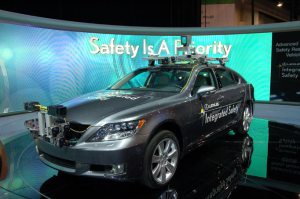The automotive industry never sleeps. Manufacturers regularly launch new cars, but even before the fanfare has died down their replacements are already on the drawing board. Running parallel to that process is development of innovative technology for every new model, often safety related, which has the power to impact on all our driving lives. Right now, the most significant area of research is autonomy.
A Technological Reality
The idea of ‘driverless cars’ isn’t new, but man’s engineering prowess is now such that taking your hands off the steering wheel and feet away from the pedals is becoming a reality. Every mainstream car brand is working on it; Lexus became the latest to go public at the recent CES Show in Las Vegas, unveiling a prototype LS rigged up with external sensors. A few stands away, Audi launched ‘piloted driving’, where a suitably equipped vehicle will move itself up to 37mph (60 km/h), no steering required. In a slightly more gimmicky move, the system will also allow the user to get out of the car and park it remotely using the keyfob or even a smartphone app.

Audi has also joined tech firm Google in being allowed by the authorities in the US state of Nevada to use driverless cars on public roads. Someone still has to be sat behind the wheel for emergency purposes but they’re not ‘driving’. Volvo has supported a ‘road train’ project where your car follows the one in front, all snaking along behind a lead vehicle. Watch a movie, read a book? No problem.
The advantages of ‘driverless’ technology are many; fewer crashes, increased lane capacity, reduced congestion, lower peak zone parking requirements and personal transport for the visually impaired are the obvious ones. But the safety implications of hardware failures, software glitches, user error and even sabotage are life-threatening. Accidents will be global front page news.
We’re already starting to see the first fruits on production cars. Adaptive Cruise Control – where your car slows or speeds up in response to the one in front – is already commonplace. Ditto with Park Assist.
Autonomous Challenges

Ironically, it’s not the technology that’s the hard bit to develop. We know how to build cars that can sense their surroundings and any hazards. The tricky bit splits into two distinct areas. The first is getting drivers to trust the technology and understanding their behaviour change as a result of it being present. Today’s motorists are a relatively untrained group with no regular refresher courses, and what the industry calls ‘de-skilling’ is already a problem.
The second issue is the big one – the legal arguments around responsibility. At the moment the 1968 Vienna Convention says a car must have someone who is legally in charge. So who is responsible when an autonomous car hits a pedestrian? The experts will say it can’t happen but it inevitably will. Is it the person behind the wheel? They’re going to say the car was supposed to stop. Or the manufacturer? Or the supplier company which made the system? It’s a big can of worms, one we seem happy to open but have yet to fully understand the consequences of.





 Facebook
Facebook Twitter
Twitter Instagram
Instagram LinkedIn
LinkedIn Youtube
Youtube